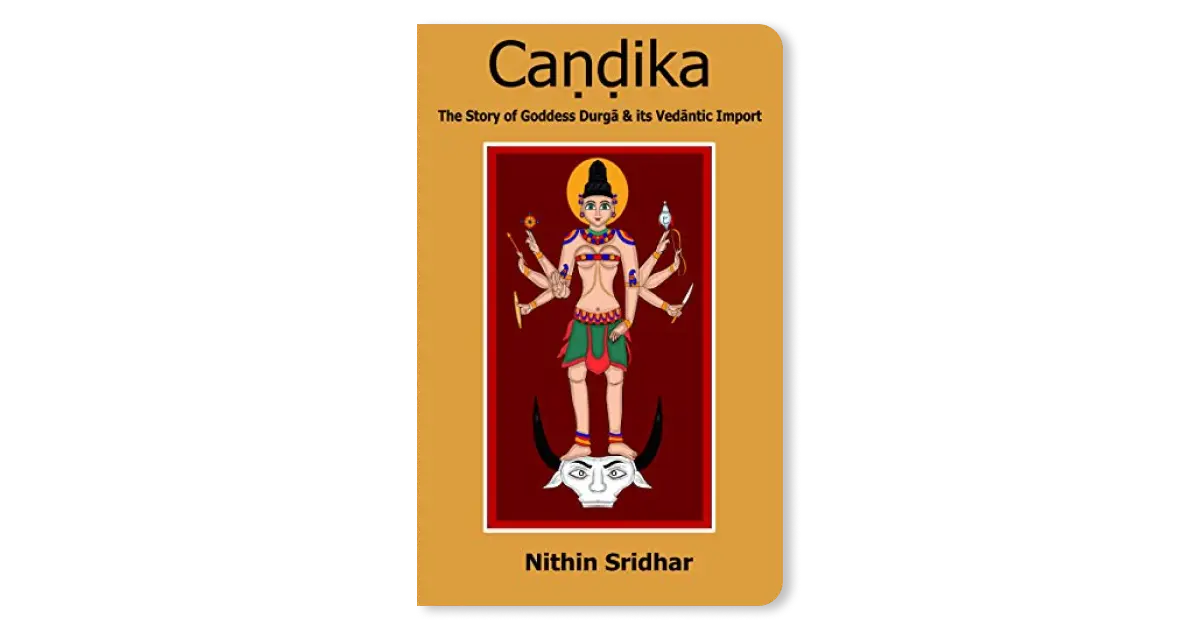
Book Review - 'Caṇḍikā - The Story of Goddess Durgā and its Vedāntic Import'
4 October, 2023
1072 words
share this article
Many times, we find ourselves practicing tradition without a clear understanding of why we do what we do. This is not a bad thing, either - it is a starting point from which we must grow and evolve.
This booklet on Devī, a quick read whether in paperback or on Kindle eBooks, is a must for those who would like to gain a depth of understanding into Devī worship - especially with the upcoming season of Navarātri and other Devī related festivals.
Śrī Nithin Srīdhar provides a needed background on Devī, specifically Caṇḍikā rūpa, with details from śāstra in an cogent, succinct manner
The introduction imparts key information on Navarātri itself, the festival of nine nights. Though there is diversity in the way it is celebrated across the globe and specifically within the regions of Bhārata, the foundational principle and association with worship of the Divine Mother remains the same.
In our busy semblance of life today, we rush through the week, Monday through Friday, to enjoy the weekends and have a good time. Our days of worship are forgotten in these, if not relegated to weekends when we might ‘have time’ for an extra temple visit or attendance of pūja. We are no longer familiar with the traditional māsa, pakṣa, or tithi as per the lifestyle of our ancestors, which were more conducive to harmony with the world around via sādhanā. Nithin jī brings to light the importance of the pañcāṅga, the Hindu calendar system, by highlighting that each year, Navarātri begins after Mahālaya Amāvasyā. Thus begins Devī Pakṣa, the fortnight which is most conducive for upāsanā to the Divine Mother.
She manifests in several forms during the first nine nights of this pakṣa. Multiple traditions are there as well, which worship specific forms on each day.
One such is captured in Devī Kavacam:
प्रथमं शैलपुत्री च द्वितीयं ब्रह्मचारिणी ।
तृतीयं चन्द्रघण्टेति कूष्माण्डेति चतुर्थकम् ॥ ३ ॥
पञ्चमं स्कन्दमातेति षष्ठं कात्यायनीति च ।
सप्तमं कालरात्रीति महागौरीति चाष्टमम् ॥ ४ ॥
नवमं सिद्धिदात्री च नवदुर्गाः प्रकीर्तिताः ।
उक्तान्येतानि नामानि ब्रह्मणैव महात्मना ॥ ५ ॥prathamaṃ śailaputrī ca dvitīyaṃ brahmacāriṇī |
tṛtīyaṃ candraghaṇṭeti kūṣmāṇḍeti caturthakam || 3 ||
pañcamaṃ skandamāteti ṣaṣṭhaṃ kātyāyanīti ca |
saptamaṃ kālarātrīti mahāgaurīti cāṣṭamam || 4 ||
navamaṃ siddhidātrī ca navadurgāḥ prakīrtitāḥ |
uktānyetāni nāmāni brahmaṇaiva mahātmanā || 5 ||
Those who follow worship in this sequence pray to the Nava Durgās, as mentioned by name in the ślokas above. These nine forms, however, are not the only ones. Other traditions exist, including those who worship the ten Mahāvidyās, and each of the three Mahādevīs as well. These traditions, and why they are interesting or significant, are covered beautifully in the opening section of the booklet.
Nithin jī goes on to detail the Legend of Goddess Caṇḍī in the first chapter of the book.
“The legend of Caṇḍī is not only about the fight of the gods with the demons, but is also about the human struggle, human fight to reach the ultimate bliss.”
Therefore, to understand Caṇḍī Devī and moreover the significance of the worship over nine nights, one must understand the story of Caṇḍī Devī as depicted in Devī Māhātmya. Nithin jī elaborates on this text with its different names, process of recitation, the Paurāṇika base, the Ṛṣi who gave the knowledge, and the sections within the Māhātmya itself.
To those uninitiated, and especially for those who have no conception of this text beforehand, the chapter provides a solid footing to visualize the tradition from the text that it is generated from. Many of us may have gone through the motions of celebrating Navarātri each year, but may not fully comprehend the depth of the actions and saṅkalpas we undertake. With a deeper insight into the textual underpinning of the festival, we are better equipped to perform the rituals and worship responsibly as a sādhakā. What are Prathama Caritra, Madhyama Caritra, and Uttama Caritra? What are these about, and how do they relate to the nine nights of the festival? Which rūpas does Devī take in each of these, and what asuras does She destroy? What does this indicate for ourselves, as worshippers of Devī during this time? All these are covered in detail in this section.
यथा ब्रह्माण्डे
तथा पिण्डेAs the universe
So the individual
In the next chapter, Nithin jī jumps to a different topic altogether by providing a philosophical overview of the Vedāntic worldview, including the ultimate goal of life (mokṣa) and the process to reach there as an individual. He weaves in fundamental concepts like avidyā, sat, cit, ānanda, mahāvākya, sādhana catuṣṭaya, citta śuddhi and each component along with their subcomponents - defining all these, and providing a map for spiritual pursuit.
Why is this significant?
It is because the legend of Caṇḍī correlates exactly, at a universal level, to this journey of ours as an individual sādhaka, as an upāsaka. Each form that Devī takes and each asurā she kills, map to the small steps we take as sādhakas, overcoming our own negative tendencies and limitations. Nithin jī goes through each of these, patiently one by one, and sheds more light also on concepts like dharma anuṣṭhāna that must be taken up throughout the year in order to be better equipped for these nine nights, the undertaking that is done during this specific time.
The legend of Caṇḍī provides deep insights into the theoretical as well as the practical aspect of the Vedāntic path to mokṣa
With Navarātrī fast approaching this year, take an hour or two out of your week to read through this booklet. It would provide us with the simple knowledge needed to perform our individual and collective duties, for the harmony and longevity of ourselves, our families, and our civilization at large.
The paperback edition of the booklet is available for purchase here, while the Kindle eBook is available here